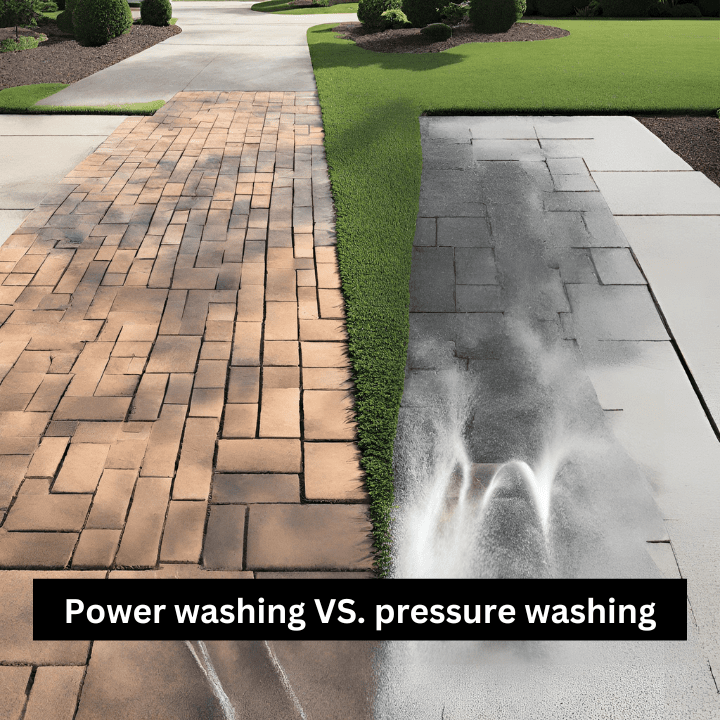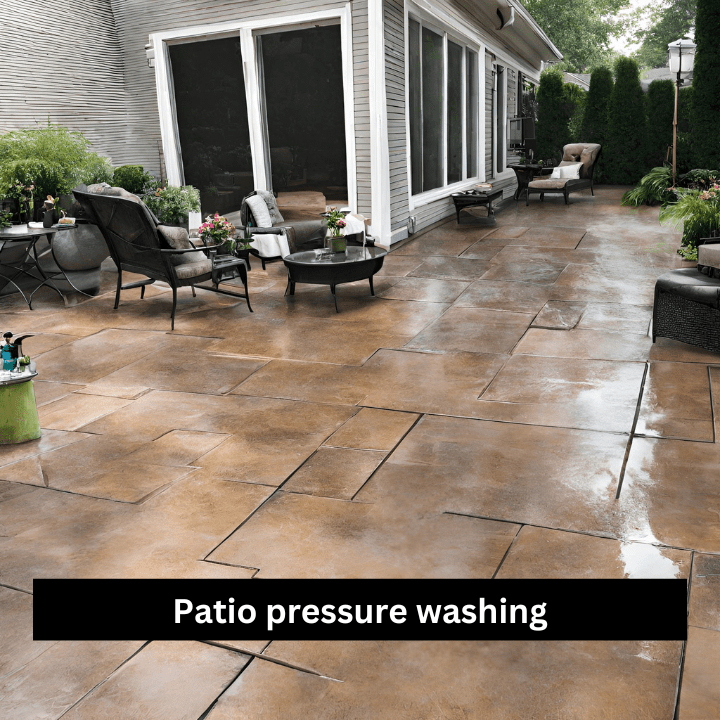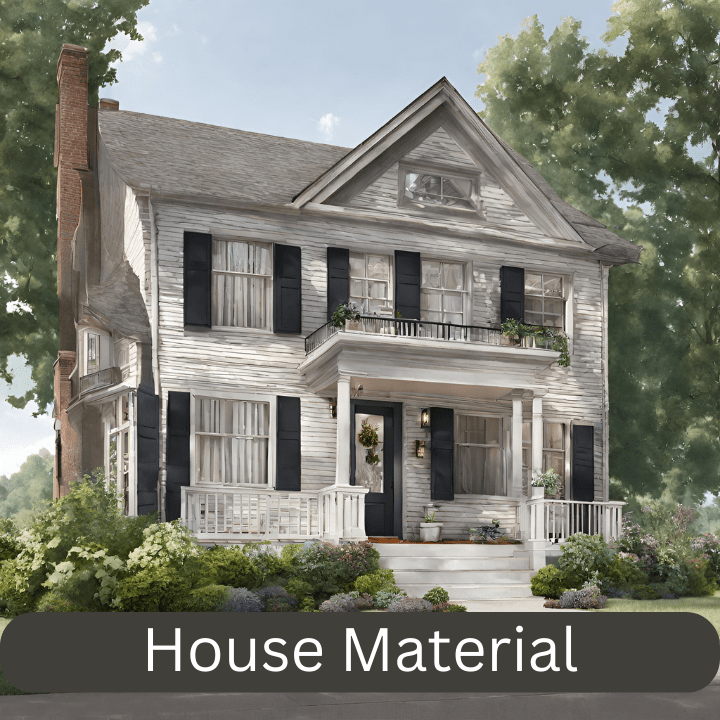There are different pressure washing prices. The typical expense for pressure washing a house hovers around $400, but it can vary from $200 to $1,250, contingent on the house’s size. Pricing is usually determined by pressure washing businesses based on the linear feet and the number of levels in a home. Professionals in home pressure washing might set a baseline fee of $200 for smaller residences, whereas pressure washing larger, multi-story homes could exceed $1,250.
Average Cost to Pressure Wash House
The typical expense for pressure washing a 2,500-square-foot, two-story house is approximately $400. The cost can fluctuate based on the home’s perimeter, measured by linear footage, and the number of levels it has.
More levels increase the linear footage, hence increasing the cost of the pressure washing job. This linear footage can differ based on the design of the house. For instance, the price for pressure washing a three-story, 3,000-square-foot home could escalate to as high as $1,250. Conversely, smaller homes around 2,300-square-feet typically range from $200 to $250, with the exact price contingent on their linear footage.
Cost to Pressure Wash House
| Cost | |
|---|---|
| Average Cost | $400 |
| Highest Cost | $1,250 |
| Lowest Cost | $200 |
What Is Pressure Washing?
Pressure washing involves the use of a gas-powered water sprayer to effectively clean various outdoor surfaces such as driveways, patios, siding, gutters, fences, and roofs. This process helps eliminate stubborn debris like oil stains from driveways and patios or peeling paint from siding. The terms pressure washing and power washing are often used interchangeably due to their similarity in function.
Power washing vs. pressure washing costs
Power washers and pressure washers both employ high-pressure water jets to cleanse surfaces, though power washing incorporates hot water rather than cold. Another cleaning method is soft washing, which utilizes eco-friendly cleaning solutions and low-pressure water.
- Power washing, costing between $0.35 and $0.77 per square foot, uses hot water and excels at eliminating dirt, salt, mold, grime, fungus, and mildew from exterior surfaces. It also removes stubborn substances like chewing gum and grease stains on driveways. The high temperature and pressure of the water can even eradicate weeds.
- Pressure washing, which costs between $0.08 and $0.20 per square foot, employs high-pressure cold water to clean houses, siding, and concrete areas such as sidewalks, fences, decks, driveways, patios, and pathways. Pressure washing usually requires a longer duration.

Difference Between Pressure Washing and Power Washing
Pressure washing and power washing are essentially synonymous. Both methods involve using pressurized water and cleaning agents to wash homes using a specialized machine called a pressure washer. Some may distinguish between the two by specifying that power washing employs hot water, while pressure washing uses cold water. Regardless of the terminology, the objective remains the same – to effectively clean surfaces using high-pressure water streams.
Pressure Washing Prices & Rates
Professional pressure washing services typically charge between $50 and $160 per hour, or an average of $0.40 per square foot, with the total cost largely dependent on the size of the job. Professionals typically visit your property to take measurements before providing a quote.
The final price is influenced by several factors such as:
The specific exterior surface that needs washing, be it a house, deck, driveway, roof, or other surfaces.
- The overall size of the area to be cleaned.
- The need for any special cleaning solutions.
- Your geographical location.
House Pressure Washing Cost Breakdown
The majority of power washing tasks are billed per linear foot, however, services for certain areas such as driveways and patios may be charged per square foot. For tasks like roof washing and gutter cleaning, a gentler approach is adopted with a soft wash rather than a pressure wash to avoid causing any damage.
Driveway
A local professional specializing in power washing typically charges between $0.20 and $0.30 per square foot for driveway cleaning. The cost can fluctuate based on the state of the driveway. Driveways that are more soiled or stained will incur higher pressure washing costs compared to those that are relatively clean.


Patio
The cost of pressure washing patios and decks typically varies from $0.25 to $0.35 per square foot. The price for power washing patios may be higher due to the professional’s need to carefully manage water runoff to avoid damaging the surrounding lawns. Similarly, decks require particular care to control water runoff.
Fence
The cost for pressure washing a fence is typically $1 per linear foot for each side. Some homeowners may choose to only clean their side of the fence, or they might agree to split the costs with a neighbor to have both sides pressure washed. In the case of wooden fences, soft washing may be necessary to avoid causing damage to the wood.


Gutters
The typical cost for cleaning gutters, which usually requires a soft wash rather than a pressure wash, is $1 per linear foot. Properties with more than 20 feet of gutters might be charged at a rate of $1.75 per linear foot. Older gutters that have oxidation problems may necessitate chemical cleaning, thereby increasing the overall cost. Homes with high gutters could also incur additional expenses, particularly if the pressure washing professionals require a bucket truck to access them. Bundling gutter cleaning with a comprehensive house wash could potentially lower the cost.
Roof
The cost of softly washing a roof that requires cleaning is typically $0.35 per square foot. Roofs are prone to aesthetic and potentially problematic issues such as bacterial growth, moss, and mildew, which can be a concern for your home insurance provider. Some insurance companies may either increase your premium or revoke your coverage if they notice the growth of moss due to the associated risks.


Siding
The cost for pressure washing siding ranges from $1 to $2.25 per linear foot, with prices escalating as the number of house stories increases. Many pressure washing companies impose a minimum charge, typically around $200, and may opt for soft washing on wood siding to avoid causing any damage. The starting price for pressure washing a one-story home measuring 60 feet wide by 42 feet long is typically $200, whereas a two-story home with the same measurements can cost approximately $625. However, these costs can fluctuate depending on the dimensions of the house and the number of stories.
Cost to Pressure Wash House
| Cost | |
|---|---|
| Average Cost | $400 |
| Highest Cost | $1,250 |
| Lowest Cost | $200 |
By Stories on House
The cost of power washing is determined by the number of levels in a house. For instance, a single-story or ranch-style home may be priced at $1 per linear foot for pressure washing. In contrast, a two-story dwelling, such as a Cape Cod, could be around $1.50 per linear foot. Meanwhile, a three-story mansion might be priced approximately at $2.25 per linear foot.


By Material
Homes are constructed using a variety of materials, each requiring specific pressure washing techniques and considerations. Depending on the material, some homes may necessitate a gentle wash, while others can withstand pressure washing. Regardless of the material type, the cost typically ranges from $1 to $2.25 per linear foot.
Wood
Usually, wood siding cleaning involves a soft wash method to avoid causing harm to the wood. This approach employs water at low pressure, combined with a blend of algaecides, bleach, and surfactants.


Stucco
Cleaning stucco can be challenging for those who prefer to do it themselves, and it’s often best left to professionals due to the precise water pressure requirements. To avoid causing any damage, stucco is usually subjected to a soft wash.
Brick
Washing brick homes may also necessitate a soft wash to avoid damaging the mortar joints. Brick houses can experience white discoloration or efflorescence, which needs meticulous cleaning for its removal.


Vinyl
Power washing vinyl siding is generally a regular task, but it’s crucial to ensure that water doesn’t seep behind the siding. If water accumulates there, it can encourage mold formation and wood decay if not addressed promptly.
Labor Cost to Pressure Wash a House
The cost of labor is typically incorporated into the per-square-foot and per-linear-foot price of pressure washing. Should you engage a local handyman to perform pressure washing on your home, the charges could range from $45 to $100 per hour.
Factors That Affect the Cost of Pressure Washing a House
The cost of pressure washing a house can be influenced by various factors, including the size of the house, level of dirtiness, specific areas to be cleaned, and the time of year. While the type of siding usually does not directly affect the cost, it does play a role in determining the cleaning process for the house.
House Size
The primary cost determinant for pressure washing a house is its size. The linear footage and the number of levels directly influence the costs. To estimate the time, resources, and cleaning supplies required for the task accurately, pressure washing firms base their quotations around these figures.
Dirtiness
Your driveway may become particularly messy with oil stains from leaking vehicles, and your roof may experience moss or mildew accumulation. Each of these situations necessitates more thorough cleaning and incurs additional charges to eliminate problem areas. Adequate roof cleaning may require the use of extra chemicals.
Items Getting Cleaned
Frequently, homeowners choose to have their gutters, driveway, or fence cleaned concurrently with pressure washing their house. While each additional service will raise the overall cost, bundling these tasks together could potentially yield a lower total price than if each service was contracted separately.
Time of Year
The cost of pressure washing a house may be influenced by the time of year. In certain regions, pressure washing businesses often experience a higher volume of work during the summer months, which might result in higher charges. Opting to have your home pressure washed during less busy periods could potentially lower the cost.
When to Pressure Wash Your House
The optimal period for pressure washing your home falls between March and November. Weather plays a crucial role in this task, as performing pressure washing during colder climates isn’t desirable. To extend the longevity of your siding, roof, and other components, it’s recommended to pressure wash your home at least annually.


How to Save Money on Pressure Washing
The decision to purchase or rent a pressure washer can be a cost-effective alternative to hiring a professional for your home’s pressure washing needs. Renting a unit can be a money-saving option, but it’s crucial to estimate the duration of its usage as rental fees from home improvement stores are typically charged by the hour.
How to Pressure Wash a House
Pressure washing a house can be accomplished in just a few simple steps, depending on the area being cleaned. In general, the process of pressure washing a house involves:
1. Pick a Pressure Washer
Selecting a pressure washer with the appropriate psi is crucial for the task at hand. For homes featuring aluminum, stucco, or wood siding, a pressure washer with a psi range of 1,200 to 1,500 is recommended. Meanwhile, those with vinyl siding should opt for a washer with a psi between 2,500 and 3,000. Additional equipment such as a pressure washer wand or telescoping wand may be required to access specific regions.
2. Prepare the Area
The preparation phase for pressure washing can be time-consuming but is essential to avoid potential damage. Items such as light fixtures may need to be taken down, and elements like air conditioners and plants should be covered.
Utilize tarps anchored with duct tape to effectively shield plants and shrubs. While surveying the house’s perimeter, take note of the positions of electrical outlets and ensure they’re sealed against water ingress. Maintain a safe distance between the pressure washer and any electrical wires.
Avoid standing on a ladder while pressure washing; instead, use wand extenders. Be cautious not to aim the pressure washer at joints, gaps, or cracks, as this can exacerbate damage. It’s advisable to fill these areas with mortar and brick beforehand.
Before commencing pressure washing, pre-clean the area using a scrub brush or a garden hose to eliminate dirt and debris. Ensure the pressure washer is never directed at people or pets. When you’re set to start washing, remember to wear safety goggles and gloves for protection.
3. Prepare the Pressure Washer
Follow the manufacturer’s guidelines to mix the cleaning solution with water in a five-gallon bucket. Connect your garden hose to the pressure washer and position yourself approximately three feet away from your house to conduct a pressure test. Continue testing until you determine the optimal pressure level to effectively remove dirt and debris.
4. Begin Cleaning from the Bottom Up
While it might seem logical to begin pressure washing from the top of your house and move downwards, it’s actually more effective to start from the bottom and work upwards. This approach helps avoid the dripping of water and cleaning solution down the house’s side. Ensure you spray in a horizontal direction as you progress. Overhangs and gutters should be sprayed at a 45-degree angle. Some individuals prefer to apply soap starting from the bottom and then rinse from the top down, but ultimately, the method employed boils down to personal preference.
5. Clean and Let Dry
Upon completion of the washing, disconnect the pressure washer and adhere to the manufacturer’s guidelines on how to correctly drain and store the sprayer. Utilize a garden hose to eliminate any residual soap from your house. Remove any tarps and duct tape from covered items once you’re finished. If you’ve prepared your house for painting, let it dry for a minimum of two days to guarantee effective paint adherence.
DIY Pressure Washing vs. Hiring a Professional
The feasibility of undertaking pressure washing tasks yourself depends on the specific task and your familiarity with the process. Pressure washing a driveway, for example, is a relatively straightforward task that can be done by most homeowners. However, more complex jobs, such as pressure washing siding or a patio, might be better suited for professionals. They possess the knowledge and expertise to wash siding without causing damage and to clean patios without adversely affecting your lawn or garden.

Frequently Asked Questions (FAQs)
The duration required to pressure wash a home can range from as little as 30 minutes to as much as three hours. This variability depends on factors such as the house’s size, the number of levels it has, and the amount of dirt and debris that needs to be cleared. Larger homes may even require up to five hours for a thorough clean. The time taken can also be influenced by the extent of preparatory work the house requires.
Many homeowners opt to pressure wash their house before listing it for sale, hoping that this will enhance its value. The process of pressure washing can improve the aesthetic appeal of the house, making it more attractive to potential buyers.
It’s not recommended to pressure wash a house when the temperature drops to 40 degrees Fahrenheit or below, as the water could potentially freeze. Moreover, if your home has numerous cracks or gaps, pressure washing might exacerbate these problems. Therefore, it is advisable to fix any deteriorating mortar before proceeding with pressure washing.

